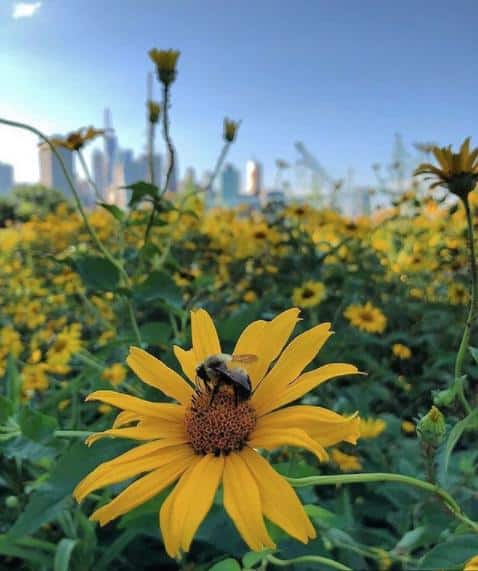Every June, we celebrate National Pollinator Week and honor these incredible animals that include butterflies, bees, birds, beetles and some bats. Pollinators feed on the nectar or pollen of flowering plants and play a vital role in horticulture and food production. Some plants are pollinated by wind or water, but 80% of plant species require an animal to help transfer pollen between flowers and begin the process of reproduction and fruiting. About one-third of the food we eat is produced with the aid of pollinators — nuts, berries, apples, melons, and cucumbers (to name just a few) are all brought to you by these amazing creatures!
National Pollinators Week is not only about celebrating these animals’ special role in ecosystems, but also bringing awareness to environmental threats that severely affect pollinator populations. Brooklyn Bridge Park is managed ecologically — this means not using synthetic pesticides and limiting the amount of disturbance to our garden beds. The Park’s horticulturalists are dedicated to planting native plants that provide food and habitat for traveling pollinators. Check out the Park’s summer plant guide and learn to identify some of these host plants currently in bloom. Summer is also the perfect season to spot active butterfly pollinators. If you find yourself going on a socially distant nature walk, use this butterfly guide to know what to look out for!

© @itsmejamey
Bees are particularly important pollinators, as they are responsible for pollinating 90% of crops worldwide. Many people are aware of Albert Einstein’s quote “If the bee disappeared off the face of the earth, man would only have four years left to live.” Unfortunately, bee populations have been declining in recent years. Scientists have observed the majority of worker bees disappearing from hives leaving behind the queen, an ample amount of food, and few larvae. This phenomenon is called Colony Collapse Disorder (CCD) and is most likely a result of some combination of the following threats:
Increased Predators and Pests: Predator and prey relationships are factors in a healthy ecosystem. However, when certain invasive species — like the Asian Giant Hornet (aka Asian Murder Hornet) — are introduced to a new ecosystem, there may be a devastating impact to honeybee populations that have no evolved defenses. Further, some wax moths and beetles are known to lay eggs in beehives. Once the larvae hatch, they eat the pollen that bees have collected. This type of organism is known as a brood parasite.
Genetic Diversity: A healthy colony requires a lot of male bees for a queen to mate with to ensure genetic diversity. Diversity allows a colony to be more resilient when faced with harsh winters or disease. If a large amount of the hive is lost to disease, invasive predators, pesticides, climate change, or other threats, the genetic diversity will be reduced.
Disease: As larvae, viral and bacterial infections can cause death or impair the ability to fly later in life. Fungi can spread quickly through a hive, affecting bees’ digestive tracts. Parasites and mites also pose a threat because they like to feed off hemolymph (insect blood)!
Habitat Loss: Humans have not only removed key habitat, but also created fragmented and isolated areas. Urbanization and monocrop agriculture have reduced plant diversity, and bee territories have shrunk by nearly 200 miles in North America!
Queen Quality: Reproduction is the sole responsibility of the queen bee who lays up to 1,500 eggs in a day! A sick or weak queen impacts the health and growth of the entire colony.
Climate Change: Climate change is causing many plants to bloom earlier in the season, affecting the seasonal cycles of pollination and bee populations. Early flowers might miss the opportunity to be pollinated by bees, while the bees might miss a vital food source.
Pesticides: Synthetic chemicals designed to kill pests are often highly toxic or deadly to bees. Additionally, pesticides are used to kill flowering weeds, like dandelions, which are one of the first food sources for bees in early spring.
The Park’s gardeners and the Conservancy’s educators use apps like iNaturalist to document pollinator species found in the Park. If you would like to learn more about how you can become a citizen scientist, visit the iNaturalist website to create a profile and start contributing data to be used in various population studies.
For more information and activities about pollinators, check out the Environmental Education Center’s Pollination Page.
Lastly, visit the National Pollinator Week website if you want to learn more about pollinators and what you can do to protect them.

